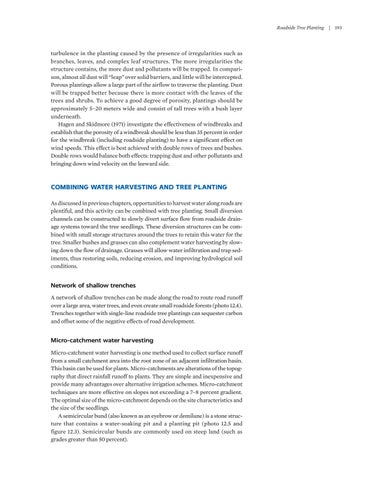Roadside Tree Planting | 193
turbulence in the planting caused by the presence of irregularities such as branches, leaves, and complex leaf structures. The more irregularities the structure contains, the more dust and pollutants will be trapped. In comparison, almost all dust will “leap” over solid barriers, and little will be intercepted. Porous plantings allow a large part of the airflow to traverse the planting. Dust will be trapped better because there is more contact with the leaves of the trees and shrubs. To achieve a good degree of porosity, plantings should be approximately 5–20 meters wide and consist of tall trees with a bush layer underneath. Hagen and Skidmore (1971) investigate the effectiveness of windbreaks and establish that the porosity of a windbreak should be less than 35 percent in order for the windbreak (including roadside planting) to have a significant effect on wind speeds. This effect is best achieved with double rows of trees and bushes. Double rows would balance both effects: trapping dust and other pollutants and bringing down wind velocity on the leeward side.
COMBINING WATER HARVESTING AND TREE PLANTING As discussed in previous chapters, opportunities to harvest water along roads are plentiful, and this activity can be combined with tree planting. Small diversion channels can be constructed to slowly divert surface flow from roadside drainage systems toward the tree seedlings. These diversion structures can be combined with small storage structures around the trees to retain this water for the tree. Smaller bushes and grasses can also complement water harvesting by slowing down the flow of drainage. Grasses will allow water infiltration and trap sediments, thus restoring soils, reducing erosion, and improving hydrological soil conditions.
Network of shallow trenches A network of shallow trenches can be made along the road to route road runoff over a large area, water trees, and even create small roadside forests (photo 12.4). Trenches together with single-line roadside tree plantings can sequester carbon and offset some of the negative effects of road development.
Micro-catchment water harvesting Micro-catchment water harvesting is one method used to collect surface runoff from a small catchment area into the root zone of an adjacent infiltration basin. This basin can be used for plants. Micro-catchments are alterations of the topography that direct rainfall runoff to plants. They are simple and inexpensive and provide many advantages over alternative irrigation schemes. Micro-catchment techniques are more effective on slopes not exceeding a 7–8 percent gradient. The optimal size of the micro-catchment depends on the site characteristics and the size of the seedlings. A semicircular bund (also known as an eyebrow or demilune) is a stone structure that contains a water-soaking pit and a planting pit (photo 12.5 and figure 12.3). Semicircular bunds are commonly used on steep land (such as grades greater than 50 percent).







































